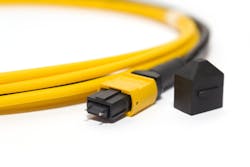Definitions and descriptions: MPO connectors and MTP connectors
MPOs (multi-fiber push on connectors) are fiber connectors made of multiple optical fibers. MPO connectors are available in 8, 12, 24, 32, 48, 60, or 72 fibers. For the smallest three, they are usually used in common data center and LAN applications. While higher fiber connectors are used in particular instances such as high-density multi-fiber arrays in large scale optical switches.
In the industry, MPOs are frequently also called MTPs. However, it is important to note that MTPs are a type of MPO connector that is a registered trademark of US Conec. MTPs are advanced MPOs with better optical and mechanical performance. Although MTPs might be more advanced, they look like and are compatible with MPOs.
The connectors come in both male and female types, the female type doesn’t have pins while the male type does.
Standards for the connectors
Manufacturers of MPO connectors must ensure that they are meeting intermateability the IEC 61754-7 and EIA/TIA-604-5 (FOCSI 5) standards. These standards are crucial in making sure that any plug and adapter that is compliant can be intermated, as well as meets performance levels. It’s also worth noting that MTP connectors meet these MPO standards.
What are MPO connectors used for?
MPO Connectors have the benefits of increasing cable density and saving circuit card and rack space. Fluke Networks writes, “MPO Connectors have been used in duplex 10 Gig fiber applications throughout the data center for several years as a way to deploy preterminated plug and play backbone cables between switches that take up less pathway space and ease cable management while offering faster deployment.”
As bandwidth speeds have gone beyond 10 Gig, and could quite possibly go to speeds of 400 Gig, MPOs have become the standard along with parallel optics.
About the Author
Serena Aburahma
Associate Editor
Serena Aburahma is an editor and writer for CI&M, with several years of experience in writing, editing, and SEO. Serena has pitched and created content for various industries, including technology, video games, insurance, cars, pop culture, and more. She has also produced content for and managed CI&M's various social media accounts and is always looking for fresh and exciting ways to grow and engage with audiences.
Much like the content Serena has written about, her interests vary as well, including writing poetry and stories, meandering in nature, playing video games, traveling, and reading.

